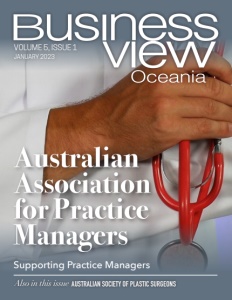Australian Physiotherapy Association (APA)
Get the Most out of Life
Business View Oceania interviews Scott Willis, President of the Australian Physiotherapists Association , for our focus on Health and Hospitals.
Since their beginnings over 110 years ago, the Australian Physiotherapy Association (APA) has worked to represent the interests of physiotherapists, students, assistants, and patients as the industry’s sole voice and peak professional body. The APA’s 30,000 members enjoy benefits such as directory representation, research database access, regular industry updates and publications, professional development and networking opportunities, Member Benefits Australia and APA partner offers and discounts, a place in the BMS Risk Solutions insurance program, and buy (shop4physios), sell (classifieds4physios), and jobs discovery (jobs4physios) opportunities. The APA advocates on behalf of members and the wider physiotherapy community to local, state, and federal governments.
Scott Willis offers his insight as the current President of the APA. “Originally, we were titled the Australasian Massage Association. We were very involved, along with our members at the time, in the physical rehabilitation of war veterans following World War I- that demonstration of our effectiveness and importance in the recovery of Australian soldiers really highlighted our value as a professional. The result was that our industry began to develop and flourish, becoming a more sophisticated, regulated sector that was instrumental in widespread uptake of active therapy. Then came the polio pandemic, which introduced the value of movement patterns and a more holistic approach to rehabilitation. Thus, we adopted the term physiotherapy, and our current title, in 1939. Since then we have championed the growth of our industry through education, advocacy, member support, CPD, and research and development. It is our belied that physio is an essential pillar of our health system and our vision that it is the patients’ foundation on which to approach the betterment of their health and wellbeing.”

APA members are invited to expand their knowledge, networking with their peers, and develop science in their area of special interest through participation in the organisation’s 20 National Groups. The groups are: Acupuncture & Dry Needling, Advanced Practice (including Emergency Department), Animal, Aquatic, Business, Cancer, Palliative Care & Lymphoedema, Cardiorespiratory, Disability, Educators, Gerontology, Leadership & Management, Mental Health, Neurology, Musculoskeletal, Occupational Health, Orthopaedic, Paediatric, Pain, Sports & Exercise, and Women’s, Men’s & Pelvic Health.
The National Groups program is a significant contributor to furthering the APA’s education mission, Mr. Willis says. “We have a few different education goals we are working towards. First, we want to educate the consumer, the patient, on what physiotherapy can offer and the massive scope of practice it holds. We also need to work with our funders to deepen their understanding of industry practices, issues, and updates as they arise. And finally, we provide continuing education and professional development opportunities for our members, which is where the National Groups come in, alongside our mentoring program and CPD (cpd4physios) resources. We look at the whole pathway, from students and graduates right through to specialisation into the College of Physiotherapy.”
The APA fosters core values accountability, excellence, courage, respect, and collaboration. In keeping with their collaborative principles, the association works regularly with other industry bodies and key partners to further their mission agenda. Partners include the Allied Health Professionals Association (AHPA), Australian Medical Association (AMA), Royal Australian College of General Practitioner (RACGP), and the National Disability Insurance Scheme. The APA is also a member of World Physiotherapy, an organisation that has served as the peak global body for physiotherapy associations since 1951.
 Mr. Willis comments on the importance of ongoing reform efforts for the physiotherapy sector, particularly in the wake of the COVID-19 pandemic. “COVID was obviously a huge challenge for us, but it has also presented an opportunity for reform in the health sector. We were really accentuated during lockdown as an essential service for patients of all kinds, and the barriers facing our physios and associated healthcare workers were made clearer to our government. Despite improvement, we are still seeing evidence that reform needs to be taken to the next level. In order to inspire, that we need to continue highlighting physiotherapy as an efficient, economical, and effective service for our patients and funders. We would like to break down those barriers to see physios represented as the foundational point of care for our patients, working alongside their general practitioners, specialists, mental health providers, etcetera, to present an integrated service that will improve their quality of life in all health-related areas.”
Mr. Willis comments on the importance of ongoing reform efforts for the physiotherapy sector, particularly in the wake of the COVID-19 pandemic. “COVID was obviously a huge challenge for us, but it has also presented an opportunity for reform in the health sector. We were really accentuated during lockdown as an essential service for patients of all kinds, and the barriers facing our physios and associated healthcare workers were made clearer to our government. Despite improvement, we are still seeing evidence that reform needs to be taken to the next level. In order to inspire, that we need to continue highlighting physiotherapy as an efficient, economical, and effective service for our patients and funders. We would like to break down those barriers to see physios represented as the foundational point of care for our patients, working alongside their general practitioners, specialists, mental health providers, etcetera, to present an integrated service that will improve their quality of life in all health-related areas.”
He continues, “There are also a lot of barriers for patients and their general practitioners in areas such as the referral process, particularly for specialist and mental health appointments. Our specialists and our GP’s need to be able to talk to each other easier, and patients need be able to access integrated healthcare systems that take a holistic approach to their mental and physical wellbeing. It’s not just about investing more money, it’s about investing time, energy, and research to get it right. There are some great innovative models of care out there that reduce the costs of the health sector for patients and funders. We believe that taking advantage of those systems is the only way true, positive reform and development of our system in Australia is going to happen.”
In 2021, the APA decided to split their Chair and President roles to highlight their different skill sets and allow better focus on separate areas of the organisation’s governance. Mr. Willis says, “As President, I look after external stakeholders, media, and government relations- essentially all the outfacing components of governance. Our current Chair, Jenny Aiken, looks at our internal governance, running board meetings, interactions with our staff group, and the operational side of what we do. This shift has been really effective and allows us to identify more strongly with our roles.”
Moving forward, the APA hopes to see significant reform in the physiotherapy industry, and indeed throughout the wider healthcare sector, to support patients as they navigate their health and wellbeing. The association will promote the introduction and implementation of integrated health systems for aged care, veteran, Indigenous, and NDIS patients in particular, which will allow a fuller scope of physiotherapy practice to be made available to them. The APA is confident that their role in the future will continue to help physios, their staff, and their patients get the most out of life.
AT A GLANCE
Australian Physiotherapists Association (APA)
What: Peak body representing the interests of Australian physiotherapists, their staff, and their patients
Where: The APA is headquartered in Melbourne, Australia
Website: https://australian.physio/




 This information will never be shared to third parties
This information will never be shared to third parties